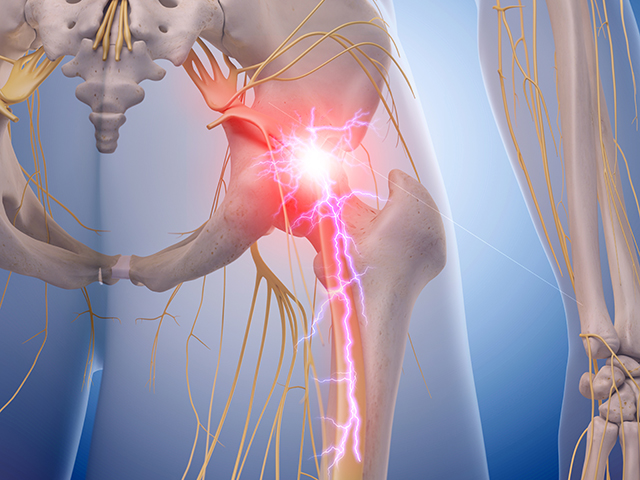
Neuropathic pain caused by back problems or diabetes can be very difficult to treat.
Anyone who’s experienced the agonizing pain from a slipped disc doesn’t want it to happen again. When the cushiony gel between adjacent vertebrae of the spine “slips” out — either from an injury or from wear and tear of the spine — nearby nerves that track down the spine get irritated, causing pain. Persistent irritation to the nerves from the displaced disk can cause the pain to last for weeks or months.
Pain caused by damage to nerves is called neuropathic pain and can be caused in many different ways, including injuries such as the back pain from disc problems and nerve damage from some chronic health conditions. Diabetes often causes nerve damage that leads to neuropathic pain in hands and feet that people with diabetes describe as burning or tingling. Other diseases such as multiple sclerosis or cancer also can damage nerves and trigger neuropathic pain.
“It’s the worst pain to have,” said Daniela Salvemini, Ph.D., a pharmacology and physiology scientist at Saint Louis University in Missouri. “We don’t have many options to treat patients, and our options have limited efficacy and many side effects.”
Opioids, though not recommended for neuropathic pain, may still be prescribed. And not only are opioids potentially addictive, they might make neuropathic pain worse. Salvemini’s research, supported through The Helping to End Addiction Long-term® Initiative, or NIH HEAL Initiative®, is aimed at discovering and testing new biological targets to relieve neuropathic pain. A key goal is to develop promising targets into safe, effective, and non-addictive medications to treat neuropathic pain.
Non-addictive Pain Medication for Chronic Pain
The search for non-opioid pain treatments is an important focus of the NIH HEAL Initiative. Several projects are looking for biological targets in the peripheral and central nervous systems, as well as in the immune and other tissue systems in the body involved in detecting and transmitting painful signals.
Salvemini has been working on this problem for some time. Her previous studies focused on the part of the spinal cord that receives pain signals from nerves all over the body. These spinal cord nerves send the signals up to the brain, where they and other signals are interpreted as pain, touch, and temperature.
This research looked at spinal cords from rats, which researchers commonly use as a model system to understand pain. To model neuropathic pain, she and her team first sedated the animals and then tied a silk thread around their sciatic nerve to cause an irritation. In humans, this nerve runs from the lower back down the back of the legs to the feet — and when it’s irritated or damaged, neuropathic pain is the result. Salvemini then looked at what genes were turned on, or activated, when the rats experienced pain about 7 days after the surgery.
One gene, GPR160, stood out. This gene makes a protein of the same name. Before this research, not much was known about this protein, except that sits on the surface of cells and receives messages from other cells, acting as what is called a receptor. Could GPR160 be carrying signals for neuropathic pain?
Salvemini’s team looked again at their rat model for neuropathic pain. After recovery from the surgery, rats with a pinched sciatica nerve are much more sensitive to cold and touch. People with long-term neuropathic pain also often become oversensitive to cold or other sensations that would not normally cause pain. In some cases, for example, even a light touch can send the nervous system into overdrive and cause severe discomfort.
To further understand this molecular process in a rat, the scientists dripped cold liquid onto a paw, which prompted the animal to flick it away in discomfort. The ability to block this flicking reaction by blocking GPR160 would be a clue that the protein plays a role in mediating neuropathic pain.
To block GPR160, the team used a technique called RNA silencing. This technique stops the cells from making the GPR160 protein. The researchers also tried another approach, giving the rats an antibody that blocks GPR160. With both strategies, the rats no longer reacted to the cold liquid and didn’t seem to experience any other side effects.
Once Salvemini knew that GPR160 was important for neuropathic pain, she wanted to understand how it contributes to sending pain signals to the brain. GPR160 is an “orphan” receptor, meaning its “key,” a molecule that attaches to the receptor as if it were a lock, wasn’t known. Salvemini searched a database of potential keys that did not have known locks. She and her colleague Gina Yosten, Ph.D., located one promising molecule named CARTp.
Injecting CARTp into the spinal cord of a healthy mouse prompted the animals to suddenly become sensitive to cold and touch — just like a rat with a pinched nerve. And the reaction could be prevented by blocking GPR160 with either RNA silencing or an antibody.
Validating GPR160 as a novel drug target for neuropathic pain
CARTp works by activating reward pathways that intersect with pain pathways in the brain. When people take amphetamines or cocaine, these reward pathways promote addiction. Therefore, blocking CARTp (and in turn, GPR160) might block the reward pathways and the pain signals.
As part of her NIH HEAL Initiative research, Salvemini is testing whether blocking GPR160 in rats blocks the rewarding effects from morphine, which acts like cocaine. If it does, a drug that blocks GPR160 could provide much-needed pain relief without any risk for addiction.
Validating GPR160 as a pain target requires confirming that blocking the gene blocks neuropathic pain in many different rat models. Salvemini will look at changes in behavioral measures of pain such as activity and sleep disruption as well as the cold-water tests.
Further details on GPR160’s function will provide a promising target for a potential pain treatment. Several other research avenues are being pursued by the NIH HEAL Initiative, including antibodies and cell-based therapies that could lead to translational and clinical studies and testing in humans.
With an estimated one in ten Americans living with neuropathic pain, an effective pain treatment is crucially needed, asserts Walter Koroshetz, M.D., Director of the National Institute of Neurological Disorders and Stroke.
“For many people with neuropathic pain, their pain is constant, and we don’t have very effective therapies. The HEAL Initiative is trying to fill in these unmet needs where opioids don’t work.”

Stay Connected
Stay up to date on the latest HEAL Initiative research advances by subscribing to receive HEAL content directly to your inbox.

Find More Projects in This Research Focus Area
Explore programs and funded projects within the Preclinical and Translational Research in Pain Management research focus area.

National Institute of Neurological Disorders and Stroke (NINDS)
Learn more about NINDS’ role in the NIH HEAL Initiative.
 U.S. Department of Health & Human Services
U.S. Department of Health & Human Services
